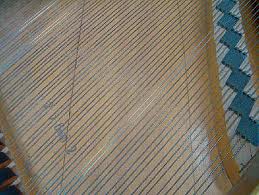Piano Soundboard Cracks and Pressure Ridges, the difference
By Willem van Suijdam, www.pianos.ph
A soundboard of a (grand) piano has a vast amount of pressure exerted on it. Used pianos will develop cracks after prolonged dry conditions. New pianos, because of new wood, will crack much sooner, sometimes even within a week after being exposed to very dry conditions. More humid conditions cause sound boards to swell, pushing the wood grain with force causing the soundboard sometimes to develop a “pressure ridge”.

When purchasing a piano check as much of the soundboard as you can see carefully for cracks. A crack is only going to get bigger and will affect the tone and overall sound of the instrument. If there is a distinct buzz when notes are struck quite firmly, this can also be an indication of a cracked soundboard. Cracks can be repaired, it is a major job and would normally take several weeks in a workshop to complete at very high cost.
Picture: Soundboard crack, major repair cost.
Cracks are bad but pressure ridges are not cracks but actually the opposite and I consider them good. Piano manufacturers will not guarantee a pressure ridge, they can be found even on many new pianos still sitting on the dealer’s showroom floor.
Of course, cracks in sound boards always indicate lack of humidity at one time or another, which then also immediately will lead to the question how good the pin block is, as it has of course also been exposed to these conditions! This is very hard to check for a customer but can be checked by an expert that has the tools to indicate pressure per square inch. The pressure should be minimum 60 pounds in dry conditions and 80 in conditions where the piano is in a humidified environment. If not, the piano will never stay in tune very long and it will be a very bad investment. To remedy the problem one needs to consider one of two things:
1) Take all existing pins out and replace them with a higher number (bigger pins). This is the least expensive option.
2) You will need a new pin block. This will mean the entire piano will have to be taken apart and rebuilt. An expensive option.
To know which one or these options is the right one; you will have to rely on your technician. The wrong decision will cost you a lot of money because bigger pins may not remedy the problem if they will split the pin block or the pin block is already split. Only an expert can give you the right information. By the way, to do these things to an upright or grand piano other than really expensive ones is not wise. It will cost you less to purchase a new piano! Back to front page.
Humidity Swings and Piano Parts
Everything in a good piano is either made of wood or depends on wooden parts to function. Wet, humid conditions swell and warps wooden parts and dry parched conditions shrinks and cracks wooden piano parts.
High humidity is bad for a piano and low humidity is even worse for a piano, and the worst is this swinging back and forth.
Temperature and humidity control are therefore critical elements in maintaining a valuable instrument.
Wood is hygroscopic and it expands and contracts across the grain with aggressive changes in humidity. The pitch of the strings depends to a certain extent on the amount of humidity present in the soundboard, which expands and contracts with changes in heat and relative humidity. If the environment is too dry, the soundboard will shrink beyond the dryness level at which the instrument was manufactured, causing cracks in the wood and even failure of glue joints.
Extreme dryness can cause complete failure of the soundboard and pin block. The loss of natural moisture in the soundboard also causes the pitch to go flat.
In the winter, care must be taken to maintain a humidity of not less than 40%, in the summer no more than 65%.
Too much moisture can ruin not only the soundboard but it also causes the wood in the keys to swell, resulting in sticking keys, loose ivory, and sluggish response in the mechanism.
Excessive moisture may also cause the strings, tuning pins and other metal parts to rust.
For whatever reason I see more Yamaha grand pianos with pressure ridges than Kawai grands, I don't know why, it's possibly different spruce, but it's just an observation from being in the business for a long time.
Conclusion: When purchasing a (grand) piano don't buy one with a cracked soundboard, a pressure ridge or 2 is all right. After purchase, make sure you protect your instrument by keeping humidity levels between 35 and 65% and you should be ok. A dampp chaser climate control system is always a good idea! Back to front page.